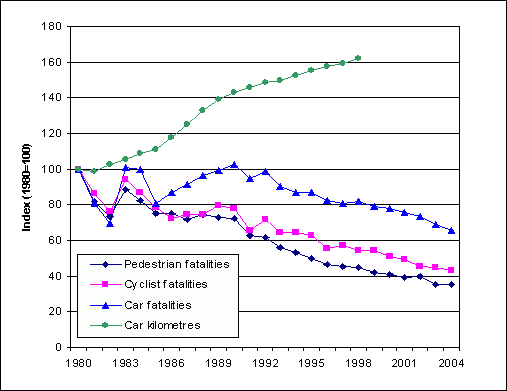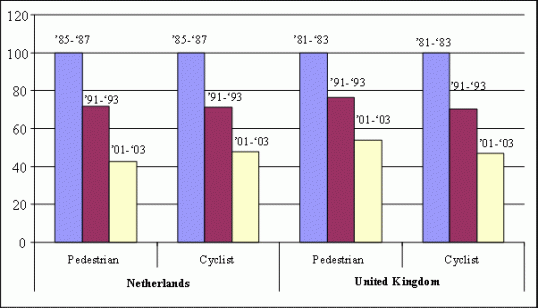General trends in number of fatalities
- Age groups most involved in fatal crashes
- Collision partners
- Contributory factors
- Crash characteristics: where and how?
- Crossing facilities
- Data considerations
- Road types
- Share of pedestrian and cyclist fatalities
General trends in number of fatalities
The trends for the number of fatalities among pedestrians and cyclists in Europe show that since 1980 both numbers have decreased by about 65 and 55% respectively. To put these figures into perspective: the number of fatalities among car drivers and their passengers only decreased by 35%. It should be noted, however, that reductions in the number of fatalities in a country cannot be evaluated without also looking at trends in mobility. Numbers of pedestrian and cyclist fatalities are affected both by the number of walkers and cyclists and the number of motorised vehicles with which they are likely to be in conflict. But mobility data on pedestrian kilometres and cyclist kilometres are only available for a few countries (see Table 4 for data for the Netherlands and the United Kingdom). Figure 2 shows index figures (1980=100) indicating the extent to which the mean number of fatalities in 16 European countries decreased and the extent to which the mean number of car kilometres travelled in 9 of those countries increased since 1980.
|   | 1981-1983* | 1991-1993 | 2001-2003 | |
|---|---|---|---|---|
| Pedestrians | UK | 27.5 | 26 | 21.3 |
| Netherlands | 10.7 | 11.7 | 13.3 |   |
| Cyclists | UK | 5.0 | 4.8 | 4.4 |
|   | Netherlands | 2.7 | 2.9 | 3.3 |
* For the Netherlands, 1985-1987 data are used
Table 4 Billion person kilometres travelled as pedestrian or cyclist. Source: SUNflower +6
Figure 2 Index numbers of average number of pedestrian, cyclist and car fatalities in 16 European Countries and index numbers for average number of car kilometres in 9 of those countries. Source: IRTAD
Looking at the reductions since 1980 for each country separately, it turns out that the reductions in the number of pedestrian fatalities varied between 35 and 75%, the smallest reduction having taken place in Greece and the largest in Germany, France, the Netherlands, and Austria. National trends in the number of cyclist fatalities were much more unstable. Some trends even showed a temporary increase in the number of fatalities among cyclists (Austria, Denmark, Hungary, Ireland, Norway, and Spain). Nevertheless, in most countries the number of cyclist fatalities eventually decreased gradually. Reductions varied between 15 and 75%, the smallest reduction having taken place in Hungary and Spain and the largest in France, Ireland, and the Netherlands.
Since exposure data are available for only a few countries, the question remains whether the reduction in fatalities were caused by a reduction in kilometrage (exposure to danger) or by an increase in safety per walking kilometre. Using the exposure data from Table 4, Figure 3 shows that in 2003 compared to the 1980s, the numbers of pedestrian fatalities per kilometre travelled and cyclist fatalities per kilometre travelled were reduced to about 50%.
Figure 3 Index of pedestrian fatalaties and cyclist fatalaties per kilometre walked and cycled respectively for the Netherlands and United Kingdom. Source: SUNflower +6


